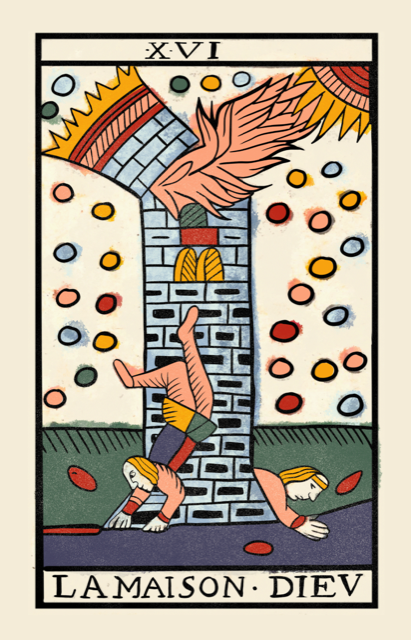AUTHOR’S NOTE: Here is another oddball experiment (I have a few of them queued up) in which pairs of trump cards are collated numerologically (similar to the “quintessence” calculation but with pre-selected components) to intentionally yield the numerical value of a third trump. The goal is to create a three-part dynamic with two “modifying” cards providing symbolic input to the third – or “principal” – one. The three can also be read as a revolving set, with different cards holding the central “focus” position. It is reminiscent of the unrelated concepts of isomorphs and Elemental Dignities but is more allegorical and impressionistic in its interpretation.
In his Tarot de Marseille book, The Tarot, French writer Joseph Maxwell spends a lot of time talking about the isomorphs – different sets of two numbers that combine to produce an identical sum – that converge in the ten “pip” cards. He examines each pip by parsing it into all of the numerological combinations that inform its meaning (e.g “5=1+4 and 5=2+3”). Fast-forward to my current reading of Benebell Wen’s I Ching, The Oracle: A Practical Guide to the Book of Changes, in which she discusses “dividing the chaos” as a way to impose order on unruly natural and sociopolitical forces, a concept that was embodied in the development of the 64 hexagrams. My personal opinion is that it resembles “reformulation” more than division, in which yin and yang lines were swapped in and out to achieve the maximum number of possible permutations. But that distinction is immaterial to my purpose here. (I will be writing a review of her book once I’ve delved further into it; right now I’m fascinated by the “mythos” but have yet to penetrate the “philosophy,” although I’m reasonably well-versed in the general thrust of the Wilhelm-Baynes translation.)
In considering Maxwell’s work with the pips, I was intrigued by the notion that it might be interesting to “reconstitute” the trump cards in a similar manner, not by using arithmetic isomorphs but rather by correlating the preceding trumps two-by-two to come up with a pattern of underlying forces exhibiting the same combined numerical value as the target trump, thus contributing to its archetypal profile. Here I’m using the Tower as an example, and I decided to create a two-tiered model that follows the I Ching’s fundamental separation into Heaven and Earth by placing pairs that end in a positive element (Fire and Air) above the principal card and those ending with a negative element (Water and Earth) below it; the first card in each set only adds to the equation numerically, not elementally. (This may not align perfectly with Chinese cosmology but it seems like a reasonable premise in tarot terms. I’ve concluded that what the tarot lacks is a “mythos” that is as deeply-rooted as that of the I Ching, so we are left to “philosophize” what little we do have.) Here are the combinations; a graphic presentation follows the text:
Fire & Air Series (Inspirational)
Justice doubled (8+8): Air (active and positive; self-supporting and well-favored by the Tower; its “conscience”)
Lover (6) and Wheel of Fortune (10): Air and Fire (active and positive; mutually friendly and both elementally agreeable with the Tower; its “champions”)
Pope (5) and Fortitude (11): Earth and Fire (mixed elements; mutually neutral and cooperative, while mostly sympathetic toward the Tower)
Popess (2) and Temperance (14): Water and Fire (mixed elements; mutually unfriendly and conflicted regarding the Tower)
The Tower, Trump XVI (Fire) – A Sudden Realization, Epiphany or “Bolt from the Blue” (more traditionally, “A Brutal Awakening”)

Water & Earth Series (Instinctual)
Juggler (1) and Devil (15): Air and Earth (mixed elements; mutually unfriendly but mostly sympathetic toward the Tower)
Empress (3) and Death (13): Earth and Water (passive and negative; mutually friendly but mostly unsympathetic toward the Tower; its “nemesis”)
Emperor (4) and Hanged Man (12): Fire and Water (mixed elements; mutually unfriendly and conflicted regarding the Tower)
Chariot (7) and Hermit (9): Water and Earth (passive and negative; mutually friendly but mostly unsympathetic toward the Tower; however, the Chariot is the “numerological counterpart” of the Tower (16=1+6=7), taking it out of “nemesis” territory)
Sorting these sets into extremes of active/positive and passive/negative, we could say that the Lover/Wheel of Fortune combo (Air and Fire) should be the most “Tower-like” (not an obvious conclusion unless we adopt Alejandro Jodorowsky’s optimistic description of the Tower as a sudden realization or epiphany – he proposes “What shall I celebrate today?” as its key message – in which case I could see the pair as implying a reasonable gamble, like “taking one’s best shot and letting the chips fall where they may”). Conversely, the Empress/Death duo (Earth and Water) is arguably the least “Tower-like” due to its profound passivity. Taking it further, we could suppose that the first two portray the Tower’s “champions” and the second pair its “nemesis,” while Justice acts as its “conscience” (to the extent that it has one).
I can see possibilities here for much philosophical contemplation by placing the Tower at the beginning, in the middle and at the end of each three-card group and exploring their engagement from both an Elemental Dignity and inherent temperament perspective. This exercise could be a valuable learning tool in understanding the interaction between all sixteen trumps in this example, particularly if the order is switched around to reflect the full complement of three-card arrays. Although I don’t use reversals with the TdM, it would be conceivable to apply the cards numbered higher than the Tower by pairing them with reversed cards that, when subtracted, produce 16, such as the Star (17) and the reversed Juggler (-1). It reads like a romantic tragedy: Wealthy Debutante (Star) + Good-for-Nothing Boyfriend (Magician reversed) + Irate Father (Mars) = Blowup (Tower). But you didn’t hear that from me . . .
